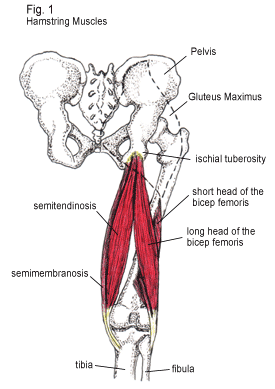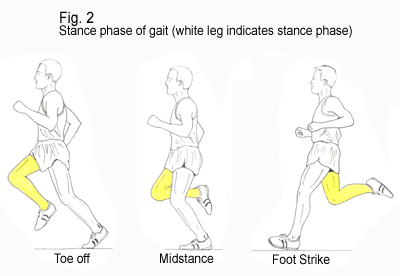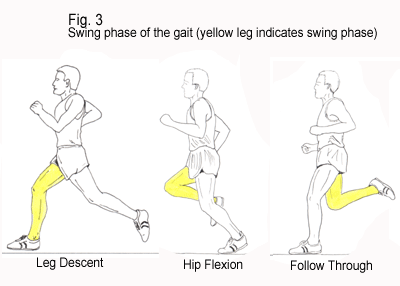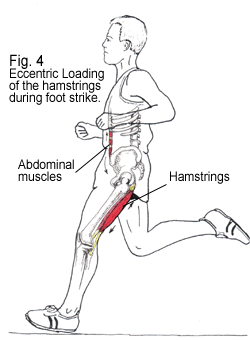
One of the most common sport-related injuries is a hamstring pull or strain. The hamstring, a group of four muscles in the back of the thigh, can be felt stretched as you bend forward to touch your toes. Three of the four hamstring muscles, the semitendinosis, semimembranosis, and the long head of the bicep femoris, cross both the hip and knee joint and are the true hamstring muscles. At the top, these muscles have a common attachment to the ischial tuberosity (a bone at the bottom of the pelvis), and at the bottom, the tendons of these muscles then attach to the tibia and fibula (bones below the knee) (Figure 1). The other hamstring muscle, the short head of the bicep femoris, only crosses the knee joint.
There are two main types of hamstring injuries, and each affects a different part of the hamstring musculature. The first hamstring injury is most common in younger athletes and is caused by a sudden motion, such as an explosive sprint, a jump, or a kick. In this type of injury, the strain occurs at the muscular portion of the hamstring, resulting in pain in the middle of the back of the thigh. Swelling and later bruising may be present in the back of the thigh, and the athlete may limp or utilize crutches to take weight off of the injured leg.
Training errors in activities such as cycling and running usually causes the second type of hamstring injury. In this case, the hamstring strain occurs at the tendinous insertion on the ischial tuberosity of the pelvis. Tri-athletes, duathletes, and marathon runners are common sufferers of this injury, and will complain of pain in the lower buttock region that increases in severity as the foot of the injured leg strikes the ground.
By understanding the biomechanics of running and some concepts of cycling, it becomes easier to understand why hamstring injuries occur and how to prevent them. With both types of hamstring strains, chiropractic treatment and re-injury prevention exercises are effective management techniques.
Biomechanics of Running
There are two phases of running: the stance phase and the swing phase. The stance phase consists of foot-strike, mid-stance, and toe-off (Figure 2); and the swing phase consists of follow through, hip flexion and leg descent (Figure 3). During an eccentric contraction, muscle fibers will slowly elongate to slow down a particular motion, while a concentric contraction involves shortening of the muscle fibers to lift an object or move a limb in a particular direction. During leg descent and foot-strike, the pelvis flexes forward and the leg extends, the hamstring muscles are eccentrically contracting to slow down both of these particular movements (Figure 4). When the eccentric load exceeds the strength of the muscle fibers, tearing of the hamstring fibers occurs, resulting in a strain injury.


 Flexibility and strength training of the hamstring musculature and the nearby muscles surrounding the pelvis and thigh will reduce the risk of injury. Strengthening the abdominal and gluteus maximus musculature is important in the prevention of a hamstring strain because these muscles aid the hamstrings in decelerating flexion of the pelvis during heel strike. Flexibility of the hip flexors and low back musculature is also important in the prevention of a hamstring strain injury. Tight hip flexors and low back musculature causes excessive flexion of the pelvis during foot-strike placing an increased strain on the hamstrings. Tightness in these muscles also inhibits strengthening of the gluteus maximus and abdominal musculature.
Flexibility and strength training of the hamstring musculature and the nearby muscles surrounding the pelvis and thigh will reduce the risk of injury. Strengthening the abdominal and gluteus maximus musculature is important in the prevention of a hamstring strain because these muscles aid the hamstrings in decelerating flexion of the pelvis during heel strike. Flexibility of the hip flexors and low back musculature is also important in the prevention of a hamstring strain injury. Tight hip flexors and low back musculature causes excessive flexion of the pelvis during foot-strike placing an increased strain on the hamstrings. Tightness in these muscles also inhibits strengthening of the gluteus maximus and abdominal musculature.
Strength training and Flexibility Training
See the following diagrams for examples of exercises to help strengthen and increase flexibility of the hamstring and surrounding muscles.
- Core training- chops, abdominal crunches, Russian twist (Figures 5, 6, 7)
- Straight leg deadlifts and squats- eccentrically strengthen the hamstring musculature
(Figures 8,9) - Flexibility training with the flexband
Talk to a doctor or certified strength conditioning specialist before attempting this or any new exercise program.

Training Protocols for Running
The initial training phase should consist of establishing a good aerobic base, a comfortable slow pace where oxygen is plentiful, allowing the body to convert stored fats and glucose for energy. A heart rate monitor can be a useful tool in training at the appropriate pace. Aerobic conditioning should be conducted at approximately 70-80% of maximum heart rate (MHR), expressed in number of beats per minute. To determine your MHR, subtract your age from 220, or by looking at your heart rate monitor after a fast all-out run up a hill. After establishing a good aerobic base, pace can be increased to 85-90% maximum heart rate, a point called anaerobic threshold training. The anaerobic threshold is the point immediately before oxygen debt occurs, and will eventually become the race pace. With proper training, the anaerobic threshold will increase — allowing the athlete to run at a faster pace before reaching oxygen debt.
Competitive and elite athletes will conduct short distance interval anaerobic training runs at 95% maximum heart rate to increase their body’s ability to deal with muscle fatigue. At this fast pace, oxygen debt ensues and energy is now produced by the breakdown of glucose to lactate, with the byproduct of hydrogen ions. In order for muscle contraction to occur, calcium needs to bind to a particular protein in the muscle fibers. Hydrogen ions compete with calcium for these binding spots, eventually inhibiting muscle contraction. The body can only function for approximately two to three minutes at this faster pace, however maintaining this pace may mean the difference between an elite runner finishing first or third at the end of a race.
Progressing training runs appropriately will reduce the risk of developing a hamstring injury by preparing these muscles for an elongated stride, as well as allowing the body to function at faster speeds before muscle fatigue and eventual muscle failure may occur.
Biomechanics of Biking
Bike racers assume a racing position that is the most aerodynamic (least wind resistant) and that is conducive to the greatest strength through pedal stroke. A racing position that satisfies these two conditions allows racers to maximize their speed. Unfortunately, this racing position places an increased eccentric strain on the hamstring and erector spinae musculature, increasing the risk of a hamstring injury. Proper flexibility and strength training, as well as bicycle conditioning and correct bike fitting, are important in attaining this strategic position while decreasing risk of injury. For more information on proper bike fitting, provided by FitWerx, click here.
Case History
Leiha came to Dr. Dubin’s office with complaints of pain in the lower left buttock region. She stated that after running the Boston Marathon she had no pain. However, soon after the marathon she started to run with a friend to train for a 5k race; that’s when she began to experience pain. It is important to note that she had run the Boston Marathon at a slow pace and with a short stride, but trained for the 5k race at a faster pace and a longer stride. Leiha had not included squats or straight leg deadlifts in her strength training routine. The pain increased to where she could no longer train.
Examination revealed extreme tenderness in the left buttock region, where the hamstrings attach to the pelvis. Tightness was evident in the left hamstrings and iliotibial band. Dr. Dubin explained to Leiha that due to her sudden increase in pace of training, her hamstring musculature was not prepared for the eccentric load placed on them. This led to her injury.
With proper treatment (see below), Leiha’s condition was resolved after 5 visits. To prevent re-injury, she was instructed on a proper strength and flexibility routine and was instructed on a strategic plan to slowly progress the pace of her training runs.
Treatment at this office
- Deep tissue procedures (Active Release Technique) to free up soft tissue motion of the hamstrings and surrounding musculature
- Adjustments to free up joint motion of the lumbar spine
- Ultrasound and electric muscle stimulation combo-therapy applied to the proximal hamstring tendons to break up scar tissue, restore normal muscle tone, and decrease pain.
- Implementation of a proper strength and flexibility program
- Advice on how to progress training runs more appropriately
For more information, or to set up an appointment with Dr. Dubin, please call 617-471-2444.

